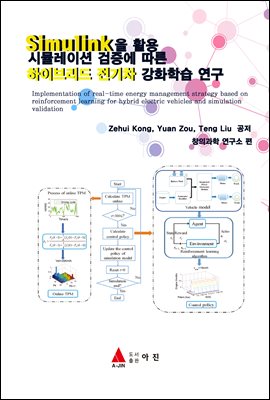
Simulink을 활용 시뮬레이션 검증에 따른 하이브리드 전기차 강화학습연구
- 저자Zehui Kong, Yuan Zou, Teng Liu 저
- 출판사아진
- 출판일2020-07-13
- 등록일2020-12-21
- SNS공유


- 파일포맷PDF
- 파일크기12MB
- 공급사YES24
-
지원기기
PC
PHONE
TABLET
프로그램 수동설치
전자책 프로그램 수동설치 안내
아이폰, 아이패드, 안드로이드폰, 태블릿,
보유 1, 대출 0,
예약 0, 누적대출 9, 누적예약 0
책소개
To further improve the fuel economy of series hybrid electric tracked vehicles, areinforcement learning (RL)-based real-time energy management strategy is
developed in this paper. In order to utilize the statistical characteristics of online
driving schedule effectively, a recursive algorithm for the transition probability
matrix (TPM) of power-request is derived. The reinforcement learning (RL) is
applied to calculate and update the control policy at regular time, adapting to the
varying driving conditions. A facing-forward powertrain model is built in detail,
including the engine-generator model, battery model and vehicle dynamical model.
The robustness and adaptability of real-time energy management strategy are
validated through the comparison with the stationary control strategy based on
initial transition probability matrix (TPM) generated from a long naturalistic
driving cycle in the simulation.
Results indicate that proposed method has better fuel economy than stationary one
and is more effective in real-time control.
목차
제 1편 : SIMULINK 기본편1.1 SIMULINK의 시작 1
블록의 연결 5
블록 파라미터의 설정 7
시뮬레이션 파라미터 (Configuration Parameters)의 설정 8
시뮬레이션의 수행 9
블록 파라미터의 표시 9
복수 데이터의 표시 11
2.2 동적 시뮬레이션 13
이차 미분방정식 17
선형 상태변수 모델 23
DC 모터의 시뮬레이션 24
함수 블록의 사용 29
차분방정식(difference equation)의 모델링 34
Subsystem(부시스템)의 구성 37
제 2편 : 연구논문
1. Introduction 41
2. Modelling of hybrid electric tracked vehicle 43
3. Real-time energy management strategy 45
4. RL-based Real-time energy management strategy 46
5. Simulation and validation 48
6. Conclusion 51
7. References 55

















